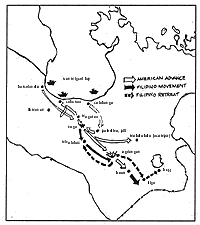|
| The Battle of Agdangan | |
The period starting from the time war with America was declared in February 1899 to January 1900, the Bicol region was relatively peaceful. General Vicente Lukban, Chief of the Filipino Army in Ambos Camarines was already assigned to lead an expeditionary force to Samar and Leyte. Over-all command of the province fell to General Antonio Guevara. In anticipation of an American invasion, lookouts were posted on the outlying coastal towns and a Corps of Militiamen was formed under the command of then Colonel Ludovico Arejola. The bulk of the regular forces was concentrated in the town of Libmanan under the commands of Estanislao Mercado and Vicente Ursua. The American invasion in the Bicol region commenced on January 20, 1900 with American landings made in Sorsogon Bay and in Albay Gulf. On February 20, an American flotilla entered San Miguel Bay and landed four battalions on three different points - Calabanga, Cabusao and Barceloneta. The battalion that landed in Calabanga under the command of Col. Parker, proceeded to move south, skirting Mt. Isarog and encamped in Palestina, Pili to attack Naga from the south. The two battalions from Cabusao, commanded by Gen. John C. Bates, joined with the battalion of Col. Goodwin from Barceloneta and entered Libmanan. This combined force then occupied Magarao to take Naga from the north. At this time, all the remaining Filipino forces chose not to engage the American advance and about a thousand Tagalog and Bicolano officers and men had moved south and had already encamped in Baao. The token force that was left in Libmanan quickly fell to the combined force of Gen. Bates and Col. Goodwin. When the Americans entered Naga from the north and south, skirmishes ensued as pockets of resistance was offered by some separated units which left almost seventy Filipinos killed. The main force in Baao retreated south and left a force of not more than two hundred soldiers in Agdangan under the command of Lieutenant Colonel Elias Angeles, the leader of the Naga uprising against the Spaniards on September 18, 1898. This detachment was apparently left to delay pursuit of the much larger force that was now on its way to Albay to reunite with the other Filipino forces. Lt. Col. Elias Angeles was an officer in the guardia civil and had some military training. He could not have picked a better place to halt the advancing enemy. The site was far from civilian population and in case of defeat there was no better place to scatter and escape the enemy. Six kilometers north of the Baao poblacion, Agdangan (called sitio Agdangan a century ago) is entered from the north across a stream called "hararom na cale". The stream is about three meters deep from the surrounding ground level and flows west to the lake of Baao. Its source are the foothills that form a sort of a "stairway" to the continuous mountain range that is connected to Mt. Iriga and lake Buhi. These mountain range is visible from Baao towards the northeast of which the highest peak is called "Simurai" by the Baaoeños. The terrain provided excellent obstacles and cover for a running battle that would be advantageous to the bolomen in case ammunition ran out. By the time the Americans entered Naga on February 22, the Filipinos in Agdangan had already started building their trenches. The defense of Naga was entrusted to the hands of Col. Ludovico Arejola who found his forces inadequate and was then in danger of being surrounded. He executed a quite and orderly retreat southeast to Minalabac and with three companies of his militia, joined Col. Angeles in Agdangan. A two-pronged attack was launched by the Americans of February 23 toward the direction of Agdangan and Ocampo (then Mabatobato). When the Americans reached Agdangan on the early morning of February 24, the trenches were already manned with sixty riflemen and the rest tiradores and bolomen. Because the defenders were well entrenched, the battle lasted for sometime, sources vary in duration from three hours to eight hours. For a time the right flank was in danger of being overrun so Col. Arejola personally led a reinforcement of twelve riflemen to help hold the line. As the battle progressed, the superiority of the Americans in number and equipment began to wear down the stubborn defenders and at noon the Filipinos ceded the ground. Slowly the trenches were abandoned and after the last sounds of gunfire were heard, the Americans found themselves alone and free to resume their march. Since no records were available to show casulaties or captured prisoners, this might attest to a successful retreat. The Filipinos had vanished by simply scattering into the surrounding brush or escaping to the trees on the foothills. A good number trekked the mountain range to Baao for Iriga and continued to Buhi, where most suffered hunger, fatigue and illness. The others like officers Angeles and Arejola were able to return to their mountain hideouts in Minalabac and for more than a year refused to heed calls for surrender.
|
|
|
|

